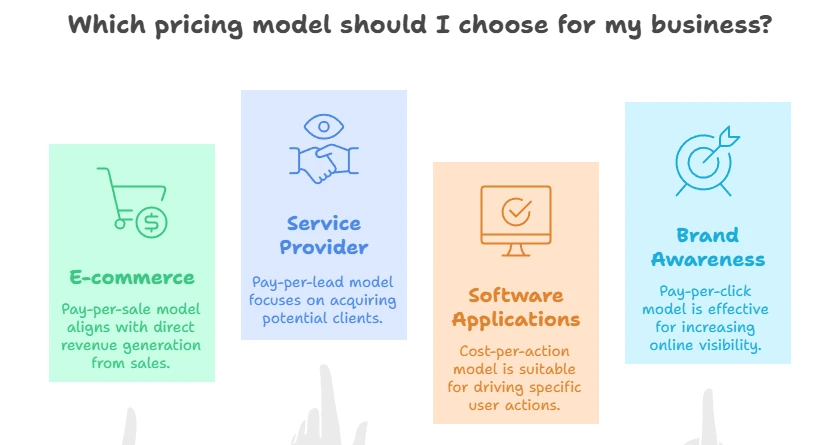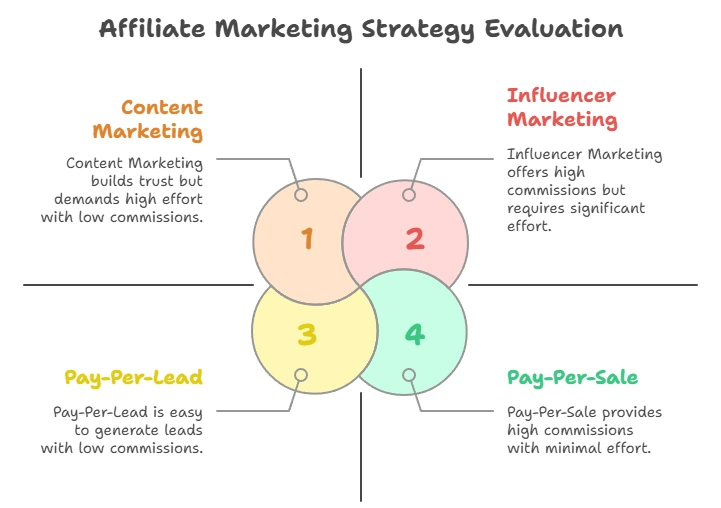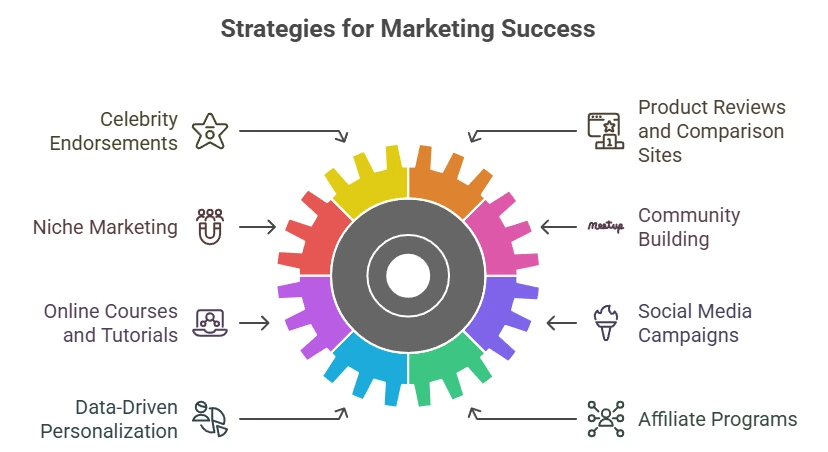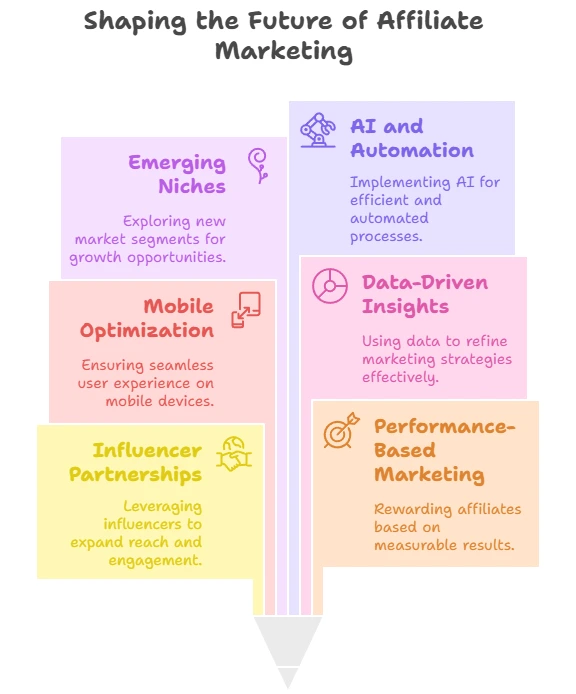
Affiliate marketing is an excellent way for businesses and individuals to earn money online by promoting products or services. Understanding the different types of affiliate marketing can help you find the best method to suit your needs and maximize earnings. Here’s an overview of the main types of affiliate marketing you might explore.
Pay Per Sale (PPS)
Pay Per Sale is one of the most common types of affiliate marketing. In this model, the affiliate earns a commission when a customer makes a purchase through their referral link. This method aligns the interests of both the merchant and the affiliate, as both benefit from sales.
How It Works
When an affiliate promotes a product, they share a unique tracking link. If a customer clicks the link and makes a purchase, the affiliate receives a predetermined percentage of the sale. This type is popular in e-commerce and often used with platforms like Amazon Associates.
Pay Per Click (PPC)
Pay Per Click is another effective type of affiliate marketing. Affiliates earn money based on the number of clicks their referral links receive, regardless of whether the customer makes a purchase.
How It Works
In this structure, advertisers pay a fixed amount for each click generated by the affiliate’s link. PPC is effective for driving traffic to advertising campaigns or product pages. It’s common in various industries and can be found on platforms like Google Ads.
Pay Per Lead (PPL)
Pay Per Lead is ideal for affiliate marketers who focus on generating leads rather than direct sales. In this model, affiliates earn commissions when potential customers take specific actions, such as signing up for a newsletter or completing a contact form.
How It Works
Affiliates promote a service or product and encourage visitors to complete particular actions. If successful, they receive compensation based on the number of leads generated. This model is often used in industries like real estate and finance.
Cost Per Action (CPA)
Cost Per Action is similar to Pay Per Lead but tends to cover a broader range of actions. Affiliates earn commissions for specific actions taken by the customer, beyond mere clicks or leads.
Examples of Actions Include:
- Signing up for a trial.
- Downloading an app.
- Completing a purchase.
This model is flexible and allows affiliates to reach diverse customer segments which makes it appealing for many marketers.
Influencer Marketing
Influencer marketing is a modern approach to affiliate marketing where individuals with a considerable following on social media platforms share products or services with their audience. These influencers typically receive commissions based on sales generated from their referrals.
Why It Works
Influencers often have a loyal audience that trusts their recommendations. By promoting products that align with their brand, they can effectively drive conversions. Many influencer marketers collaborate with brands using platforms such as Impact or AffiliatePrograms.com.
Affiliate Networks
Affiliate networks act as intermediaries between merchants and affiliates. They provide a platform for both parties to connect. Networks simplify the process by offering a variety of products for affiliates to promote, along with tracking and reporting tools.
Key Benefits of Affiliate Networks:
- Access to multiple affiliate programs in one place.
- Simplified payment processing.
- Enhanced tracking and reporting for marketing campaigns.
Examples of popular affiliate networks include ShareASale and ClickBank.
Choosing the Right Model for You
When exploring the various types of affiliate marketing, it’s essential to consider your audience and niche. Each model comes with its benefits and works best in specific scenarios. Experimenting with different types can help you find the best approach that aligns with your goals. Regardless of the model you choose, remember that success in affiliate marketing requires building trust with your audience and providing value. Focus on promoting products or services you believe in, and always engage authentically with your readers.
How to Choose the Right Affiliate Marketing Model for Your Business
Choosing the right affiliate marketing model can significantly shape the success of your business. It’s essential to align the model you select with your goals, products, and target audience. There are several popular affiliate marketing models to consider, each with its advantages and nuances.
Pay-per-click (PPC)
In the pay-per-click model, affiliates earn a commission based on the number of clicks they drive to the merchant’s website. This model works well for businesses with high conversion rates.
- Advantages: Can generate quick traffic and create brand awareness.
- Considerations: It can be expensive if not managed correctly. Analyzing the return on investment (ROI) is crucial.
Pay-per-sale (PPS)
The pay-per-sale model rewards affiliates with a commission after a customer makes a purchase through their referral. This is a common model in many affiliate programs.
- Advantages: This model is highly rewarding for both the merchant and the affiliate, as it only pays once a sale occurs.
- Considerations: It may take time to see results since sales cycles can vary.
Pay-per-lead (PPL)
In the pay-per-lead model, affiliates earn commissions by generating leads (like sign-ups or inquiries) rather than direct sales. This model is particularly effective for service-based industries.
- Advantages: Often requires less effort from potential customers than making a purchase, leading to potentially higher conversion rates.
- Considerations: Quality of leads is crucial to ensure that customers convert into actual sales later.
Cost-per-action (CPA)
Cost-per-action is a flexible affiliate model where affiliates are paid for a specific action, such as signing up for a newsletter or downloading an app. This model incentivizes a variety of actions.
- Advantages: Diverse actions can increase engagement and offers more ways to earn commissions.
- Considerations: Requires clear communication with affiliates about what counts as an action to avoid confusion.
Choosing the Right Model for You
To choose the best model for your business, consider the following:
| Business Type | Recommended Model |
|---|---|
| E-commerce | Pay-per-sale |
| Service Provider | Pay-per-lead |
| Software Applications | Cost-per-action |
| Brand Awareness | Pay-per-click |

Each model has its place in the affiliate marketing landscape, and the right one often depends on your specific needs. Understanding the characteristics of your audience and what motivates them will play a crucial role in making this decision.
Identifying Your Target Audience
Before settling on an affiliate marketing model, it’s essential to identify your target audience. Knowing what they value can help you choose the right approach:
- Demographics: Age, gender, income level, and location can influence which products or services they are likely to purchase.
- Interests: Understanding the hobbies and preferences of your audience can help tailor your affiliate strategies.
- Buying Behavior: Analyze how often they purchase and what factors influence their decisions.
To start your journey into affiliate marketing, consider checking out resources like ShoutMeLoud and Big Commerce. These platforms offer insights and tips that can help you optimize your strategy and navigate the affiliate landscape effectively.
By understanding the different types of affiliate marketing models and carefully considering your business needs and audience, you’ll be better equipped to implement a successful affiliate marketing strategy. Each model has its unique strengths, so take your time to evaluate which one aligns best with your business objectives.
The Pros and Cons of Various Affiliate Marketing Strategies
Affiliate marketing has become a popular way for individuals and businesses to earn extra income. However, not all affiliate marketing strategies are created equal. Understanding the pros and cons of various affiliate marketing strategies can help you choose the right one for your needs and goals. Let’s explore some of these strategies so you can make an informed decision.
Pay-Per-Sale (PPS)
In the Pay-Per-Sale model, affiliates earn a commission when a customer makes a purchase through their referral link. This is one of the most common affiliate marketing strategies.
- Pros:
- High commission rates, as affiliates earn a percentage of the sale.
- Suitable for high-ticket items, leading to larger earnings.
- Cons:
- Affiliates need to drive a significant amount of traffic to make sales.
- Potentially longer sales cycle, which can delay payouts.
Pay-Per-Click (PPC)
The Pay-Per-Click model earns affiliates a commission each time someone clicks on their affiliate link, regardless of whether a sale is made.
- Pros:
- Immediate payout, providing quicker returns on your marketing efforts.
- Good for generating traffic and growing an audience.
- Cons:
- Lower commission rates compared to PPS.
- Affiliates might need to invest in paid media to drive traffic.
Pay-Per-Lead (PPL)
With the Pay-Per-Lead model, affiliates earn money when a user signs up or provides contact information, rather than making a purchase.
- Pros:
- Generally easier for affiliates to generate leads compared to actual sales.
- Useful for targeted niche markets where leads are valuable.
- Cons:
- Commission can be lower, as it’s usually a flat fee per lead.
- Quality of leads may vary, affecting profitability.
Influencer Marketing
This strategy involves using social media influencers to promote products and services to their large followings. Influencers may use any type of affiliate commission model.
- Pros:
- Access to a loyal audience that trusts the influencer, leading to higher conversion rates.
- Promotes brand awareness effectively through engaging content.
- Cons:
- Finding the right influencer can be time-consuming.
- Costs can escalate, especially for prominent influencers.
Content Marketing
Utilizing blogs, videos, and other content types, this strategy aims to create valuable information that directs readers to affiliate products.
- Pros:
- Builds trust with your audience as you provide genuine value.
- This strategy can lead to sustainable long-term traffic through SEO.
- Cons:
- Requires significant investment of time and effort to create quality content.
- Results may take time to materialize, depending on your SEO effectiveness.
Comparison Table of Affiliate Marketing Strategies
| Strategy | Pros | Cons |
|---|---|---|
| Pay-Per-Sale | High commissions, Best for high-ticket items | High traffic needed, Longer sales cycle |
| Pay-Per-Click | Immediate payout, Good for traffic | Lower commission rates, Paid media investment |
| Pay-Per-Lead | Easier to generate leads, Targeted marketing | Lower commissions, Varying lead quality |
| Influencer Marketing | Access to loyal audience, Brand awareness | Time-consuming to find influencers, Higher costs |
| Content Marketing | Builds trust, Sustainable traffic | Time-intensive, Delayed results |

Understanding the pros and cons of various affiliate marketing strategies allows you to tailor your approach based on your goals. Choose the model that resonates with you, and you can set yourself up for success in this lucrative field. For more insights, check out resources like Smart Passive Income or HubSpot’s Affiliate Marketing Guide.
Success Stories: Brands That Excelled with Unique Affiliate Marketing Approaches

Affiliate marketing has become a cornerstone for many brands, and some have truly shined by adopting unique approaches tailored to their audiences. Let’s explore a few remarkable success stories that showcase how these brands excelled through innovative and engaging affiliate marketing strategies.
Celebrity Endorsements: The Fashion Revolution
Brands like Revolve have taken the concept of affiliate marketing to new heights by partnering with celebrities and influencers. They empower social media personalities to create content that resonates with their followers, turning a simple promotional strategy into a lifestyle movement. Influencers promote their products through curated fashion looks, share authentic reviews, and engage directly with their audience, driving significant traffic and sales.
Product Reviews and Comparison Sites
Another brand that has reaped the benefits of affiliate marketing is HomeAdvisor. This platform excels in providing users with detailed product reviews and comparisons. By utilizing affiliate links within these reviews, they ensure that customers can easily make informed decisions. Not only do they drive traffic to their affiliate partners, but they also build trust with their audience by honestly evaluating product quality.
Niche Marketing: Catering to Specific Audiences
Focusing on specific niches is another powerful way brands are succeeding in affiliate marketing. For instance, FatCow, a web hosting service, has tailored its marketing strategy to target small businesses and entrepreneurs. Through targeted content and a network of affiliates who specialize in small business needs, they have created a community that shares valuable resources, attracting customers who benefit from their services.
The Power of Community Building
MyFitnessPal embraced the concept of community in their affiliate marketing approach. By creating an engaging platform where users can track fitness and nutrition, they encourage affiliates to share their personal journeys. Those affiliates recommend health products that they’ve personally used, making the marketing feel authentic. This sense of community not only drives conversions but also fosters loyalty among users and affiliates alike.
Utilizing Online Courses and Tutorials
Another standout approach is seen with brands like Udemy, which uses affiliate marketing through online courses. They partner with course creators who share their expertise in exchange for promoting courses. These affiliates promote their own learning experiences, letting their followers know which courses are worth investing in. This strategy builds a network of trust where users are more likely to engage and invest in their education.
Engaging Social Media Campaigns
Brands such as Glossier have mastered social media affiliate marketing by encouraging user-generated content. By incentivizing customers to share their experiences with products using specific hashtags, they leverage their audience’s reach. Participating affiliates create organic buzz, engage with new potential customers, and promote sales through social proof.
Data-Driven Personalization
One of the newer strategies is data-driven personalization. Companies like Spotify utilize detailed analytics to tailor their affiliate marketing efforts based on user preferences. Through targeted suggestions and referral links, they enhance user experience and drive traffic to affiliate partners. Personalization in marketing not only improves conversion rates but also fosters long-term engagement.
Affiliate Programs Built on Trust
Brands recognizing the importance of transparency in affiliate marketing can achieve great success. For example, Airbnb developed an affiliate program that encourages authentic relationships between hosts and affiliates. By granting affiliates access to numerous resources and valuable feedback, Airbnb builds a community of trustworthy partners who are motivated to share the brand with their networks. These examples illustrate that there are various creative strategies brands can employ in their affiliate marketing efforts. By focusing on unique approaches, building communities, and prioritizing trust and engagement, companies can elevate their affiliate marketing to new levels, ensuring long-term success in their industries.
Future Trends in Affiliate Marketing: What’s Next for Affiliates?

Affiliate marketing continues to evolve, presenting fresh opportunities and challenges for marketers. Staying ahead requires understanding how various trends can shape the future landscape of affiliate programs. As technology advances and consumer behavior shifts, affiliates must adapt to leverage these changes effectively.
Growth of Influencer Partnerships
The rise of social media has led to an increasing number of brands partnering with influencers for affiliate marketing. Influencers have established trust with their audiences, providing a unique advantage when promoting products. This trend is expected to grow as brands recognize the value of authentic endorsements. Collaborating with micro and macro influencers allows brands to reach diverse demographics, enhancing their marketing strategies.
Performance-Based Marketing Models
More businesses are adopting performance-based marketing models, where affiliates are rewarded based on specific outcomes—such as sales, leads, or clicks. This shift emphasizes accountability and ROI, fostering trust between brands and affiliate marketers. Advertisers can minimize risks by only paying for verified results, making performance-driven strategies a vital trend in the affiliate space.
Mobile Optimization
With the increasing use of smartphones, mobile optimization is essential for affiliate marketing success. Affiliates must enhance their mobile strategies to reach users effectively. Here are some key tactics to consider:
- Develop mobile-friendly websites and landing pages.
- Utilize SMS marketing to engage potential customers.
- Implement app-based affiliate programs targeting mobile users.
Mobile optimization is crucial for ensuring a seamless user experience, leading to higher conversion rates.
Data-Driven Insights
Data analytics will continue transforming affiliate marketing. By utilizing tools to gather and analyze data, affiliates can gain insights into customer behaviors and preferences. Understanding this information allows marketers to tailor their content and strategies effectively. Key areas where data-driven insights can significantly impact include:
- User demographics and engagement patterns.
- Successful content topics and formats.
- Optimal times for promotions and marketing activities.
As technology advances, the ability to harness big data will become even more critical for affiliates striving for success in competitive markets.
Emergence of New Niches
As consumer interests evolve, new niches in affiliate marketing will emerge. Sectors such as eco-friendly products, health technology, and subscription-based services are gaining significant traction. Affiliates who focus on these underserved markets can benefit from less competition and increasing consumer demand. Identifying and capitalizing on these trends presents affiliates with ample opportunities for growth.
Artificial Intelligence and Automation
Artificial intelligence (AI) is rapidly changing the landscape of various industries, including affiliate marketing. Utilizing AI tools can streamline processes, enhance targeting, and improve overall efficiency. Some practical applications of AI in affiliate marketing include:
- Predictive analytics to anticipate consumer behavior.
- Chatbots for immediate customer engagement.
- Automated marketing campaigns based on user data.
AI can significantly reduce the workload of marketers, allowing them to focus on creativity and strategy instead.
Focus on Compliance and Transparency
With increased scrutiny regarding data privacy and consumer rights, compliance will remain a top concern in affiliate marketing. Affiliates must prioritize transparency in their practices, ensuring that they disclose partnerships and align with regulations such as GDPR. Establishing trust through honesty will enhance the relationship between customers and brands, fostering long-term loyalty.
Utilization of Podcasts and Video Content
The consumption of podcasts and videos has soared in recent years, presenting affiliates with new channels to promote products. Creating engaging audio and visual content can effectively convey messages and captivate audiences. Consider the following methods:
- Host discussions or interviews with industry experts.
- Create tutorial videos showcasing product benefits.
- Leverage social media platforms like TikTok for short, impactful promotions.
By integrating multimedia content, affiliates can enhance their reach and engagement rates. Keeping up with these trends will be crucial for anyone looking to succeed in the evolving affiliate marketing landscape. As you navigate these changes, consider visiting resources like Big Commerce and Shopify Learn for additional insights and strategies on how to thrive in this dynamic marketplace.
Conclusion
As we’ve explored the myriad types of affiliate marketing, it’s clear that understanding these models is crucial for success in today’s digital marketplace. Choosing the right affiliate marketing approach is not a one-size-fits-all decision; it requires careful consideration of your business goals and target audience. Whether you’re leaning towards pay-per-click, pay-per-lead, or pay-per-sale, each strategy has its own advantages and drawbacks that can influence your outcomes.
The case studies of brands that have successfully navigated unique affiliate marketing strategies demonstrate the potential impact of creativity and innovation in this space. Their experiences highlight the importance of aligning your affiliate partnerships with your brand values and audience preferences. By learning from these success stories, you can identify effective tactics that may work for your business.
Looking ahead, the future trends in affiliate marketing present exciting opportunities. From influencer collaborations to the integration of AI and data analytics, affiliates can expect to see growth and evolution in the ways they connect with consumers. Staying informed about these upcoming trends will empower you to adapt and thrive in an ever-changing environment.
Embracing the right type of affiliate marketing, understanding its pros and cons, and keeping an eye on future developments can significantly enhance your marketing efforts. With dedication and the right approach, you can harness the power of affiliate marketing to drive brand awareness, engagement, and sales for your business.